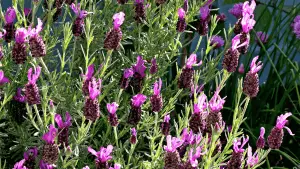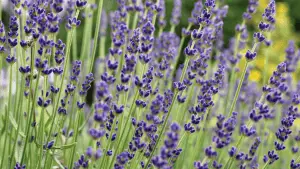Have you been thinking about growing lavender in your home garden? Lavender can be a tricky plant to grow, depending on your location. In this post, we’ll look at how to plant, grow, and care for your lavender plants to keep them healthy and lush for decades to come.
Lavender is a popular fragrant perennial plant with gray-green foliage that comes in a compact shrub form with upright flower spikes. It’s a must-have for any herb gardener since both the flowers and leaves are edible. Not to mention the fragrance and beauty it brings to your yard. For centuries this herb has been coveted for its calming presence, decadent fragrance, and its healing properties.
Lavender thrives in poor soils and can bloom year after year for many decades. It usually has purple blooms (hence the name), but you can also find different varieties with white or pink flowers. As an added bonus, once the plant is established, it requires very little maintenance aside from yearly pruning and harvesting its dazzling spikes.
Growing lavender is not a difficult endeavor. While the plant has a few strict preferences that it’s unwilling to compromise on, caring for lavender easily becomes second nature once you understand its unique needs, so let’s delve into everything you need to know about planting, growing, and caring for lavender.
Planting and Growing Lavender
While the lavender plant is a hardy perennial that thrives in different climates, it has to be planted during the right season in order to get established before extreme temperatures hit. The best time to plant lavender is during spring, once the chance of frost has passed. Planting in spring allows the roots of the lavender plant to comfortably establish themselves in the soil and allows the plant to thrive in both the heat and cold.
Soil Preparation
When planting, you want to use soil that is well-drained and slightly alkaline. Drainage is critical as lavender plants are prone to die from rotting roots caused by soggy soil. In regions where the plant is winter handy, consider winter drainage too. Soil that holds water in during winter can kill the plant quickly.
You can enhance drainage by creating raised soil mounds of about 12 inches to 24 inches in height to plant your lavender plants. Consider also mixing small limestone or sharp sand fines into the soil to enhance drainage. To make the soil alkaline, mix some limestone gravel or oyster shell into the planting holes. Some gardeners add a mixture of bone meal, lime, and compost into the planting holes to jump-start plant growth and make the soil alkaline. Keep in mind that lavender thrives in poor soil, so be sure not to over-amend.
Spacing and Planting
Lavender doesn’t like to be overcrowded. When choosing your planting location, you want to give it enough room to accommodate its flowers. You should ideally try spacing the plants as far apart as they will grow tall. This will give the lavender the air circulation it needs to thrive.
Most gardeners prefer to plant lavender transplants instead of starting the plant from seed. When planting transplants, dig a hole that’s deep enough for the roots and tuck it into place, ideally snugging some soil around it. Plant it no more deeply in the ground than where it sat while in the nursery pot.
Starting from Seed
Growing lavender from seed can be a bit more difficult, but it’s not impossible. You should sow the seeds in a sterile seed starter mix. Place the seed on top of the mix and moisten them lightly, as they need access to light in order to germinate. The seeds may require as long as one month to germinate. However, you can help the germination process by putting the seed trays in a warm spot, ideally 70 degrees, or using a heat mat.
Once the seedlings sprout a few sets of leaves, transfer them into 2-inch wide pots. Lavender generally grows slowly, and it may need one to three months to reach the transplanting size. Be sure that you provide good air circulation during this early going time to reduce disease outbreaks.
General Lavender Planting Tips:
- Lavender should be planted in the ground, ideally in the sunniest spots of your garden. These plants will tolerate many different growing conditions, but they thrive in full sun, and warm, well-draining soil.
- In the garden, it makes a great companion plant for almost anything, from cabbage to roses. Lavender is one of those herbs that even deer like to avoid, which makes it a great choice for people who need a decoy in their beds.
- Lavender is not a plant you want to depend on as a hedge. While the USDA zones for growing lavender include 5a to 9a, realistically, you may expect the plant to do well when the weather is cooperative, but be ready to deal with the occasional loss of a plant or two following a humid, wet summer, or a severe winter.
- Consider starting new plants regularly to ensure you have a bountiful harvest year after year.
How Much Watering Does Lavender Need?
Once the lavender plant is established, it tends to be remarkably drought resistant. Commercial lavender farms actually only water their plants a few times a year. However, newly transplanted lavender is a bit needier. And since you don’t want these babies to dry out, consider following the watering schedule below for a good chance of success.
Newly transplanted lavender:
Soak the root zone thoroughly with water from the plant’s base. Consider adding a diluted kelp solution to lower the chance of transplant shock.
First 30 days after transplant:
Water the new lavender plants generously every week if there isn’t any rain.
After one month:
Reduce the watering frequency to once every 2 to 3 weeks and skip in case there has been significant rain.
Established plants:
After 6 months, the plants should be doing well. You may only need to water them in the hottest and driest parts of the summer months.
No matter the stage of life of your lavender, avoid watering it from above. These plants hate having the stems or foliage wet, unless during unavoidable rainstorms.
Caring for Lavender
Just as with most plants, how well your lavender thrives will depend on what kind of growing conditions you provide and what varieties you choose to grow.
Light
Lavender plants need sunshine; at least 8 to 10 hours of direct sunlight every day. They should ideally be planted in the south-facing section of the garden. Don’t forget that these beautiful plants prefer to grow on the open, hot slopes of Mediterranean Europe. They like basking in the sun for as much as possible. Ensure that your plants aren’t going to be shaded by neighboring shrubs, trees, or structures.
Soil
Lean soil will essentially encourage a higher concentration of oils in the plants. As such, you should go easy on the fertilizer and organic matter once the plants are established. As mentioned earlier, lavender plants prefer well-drained soils that are ideally on the drier side. An alkaline or chalky soil will help enhance the fragrance of your lavender plants.
Humidity and Temperature
Lavender is hardy and it can withstand a wide range of temperatures. However, dampness is usually the more common culprit for killing lavender plants than cold. Dampness comes in the form of high humidity during summer or wet roots during the winter months. If humidity is an issue, ensure you have plenty of space between your plants to allow for airflow.
Consider planting your plants next to a brick or stone wall to protect them from harsh winter winds. This should also provide additional protection and heat.
Fertilizer
Consider adding a handful of compost into the hole while starting the lavender plants. Beyond this, feeding won’t be necessary as it can detract from the overall potency of the plant.
Pruning
While lavender plants often get pruned by harvesting their flowers, some spring pruning is recommended to keep them healthy, well-shaped, and encourage new growth. For the taller varieties, cut the plants back by about a third of their height. The shorter varieties can be cut back by a couple of inches.
If you’re in an area where your plants suffer winter die-back, avoid pruning the plants until you see new green growth around the base of the plant. Disturbing the plants too soon in the season could stop them from developing new growth.
Keep in mind that you can use pruned stems to propagate more lavender plants. You can do this by taking the cuttings while pruning and then rooting them. Ensure that there is at least one lower node that can sprout new roots into the potting medium.
Popular Lavender Varieties
There are over 45 species under the Lavandula genus and more than 450 unique cultivars. This can make it quite confusing to understand lavender varieties. However, the four main types of lavender include:

Spanish Lavenders (Lavandula stoechas)
These are known for their pine-cone-shaped flowers and their “rabbit ear” bracts. This variety can tolerate the most heat and humidity, which makes them great for southern climates. They have a scent reminiscent of rosemary, pine, and eucalyptus.

French Lavenders (Lavandula dentata)
These characteristically feature fluffy flowers, extra bloom time, and tooth-shaped leaves. While they are mostly ornamental, they have a nice charm and fragrance. They do well in mild climates of zones 7 to 10.

English Lavenders (Lavandula angustifolia)
These are coveted for their fragrance and are the infamous “true lavenders” with their tight flower spikes and slender stems. They can withstand the coldest temperatures and are generally great for northern climates.

Lavandin Hybrids (Lavandula intermedia)
These are typically bred for their high essential oils content. They have aromatic, sage-like foliage, with delightful perfume scents and a wider adaptation to zones from 5 to 10. Since their seeds are sterile, they can only be propagated by cutting.
Final Thoughts
Growing lavender in your home garden can be a rewarding experience, but it’s important to plant them at the right time of the year and give them a little TLC until they are well established. With the right soil, temperature, humidity, and fertilizer conditions in place, you can enjoy a lush display of fragrant lavender plants for years to come. Happy gardening!

